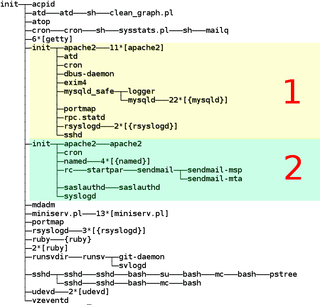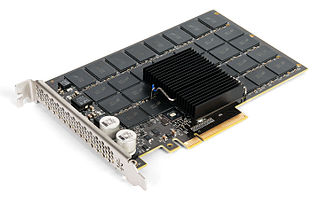Jens Axboe | |
|---|---|
| Born | 1976or1977(age 46–47) [1] |
| Occupation | Software engineer |
| Employer | |
| Notable work | CFQ |
Jens Axboe (born circa 1976) is a Linux kernel hacker. [2]
Jens Axboe | |
|---|---|
| Born | 1976or1977(age 46–47) [1] |
| Occupation | Software engineer |
| Employer | |
| Notable work | CFQ |
Jens Axboe (born circa 1976) is a Linux kernel hacker. [2]
Axboe is the current Linux kernel maintainer of the block layer and other block devices, along with contributing the CFQ I/O scheduler, Noop scheduler, Deadline scheduler, io_uring and splice I/O architecture. Jens is also the author of the blktrace utility and kernel parts, which provides a way to trace every block I/O activity in the Linux kernel. blktrace exists in 2.6.17 and later Linux kernels.
To facilitate his block layer work in the Linux kernel, Axboe created the flexible I/O tester (fio) benchmarking and workload simulation tool. [3] fio is able to simulate various types of I/O loads, such as synchronous, asynchronous, mmap, etc., as well as specifying the number of threads or processes, read vs. write mix, and various other parameters. fio was used to set the record in December 2012 for the highest number of I/Os-per-second (IOPS) in a single system. [4] [ failed verification ]
In May 2010 Axboe joined Fusion-io after leaving Oracle Corporation. [5] He announced on a mailing list on Friday, January 24, 2014, that he was leaving Fusion-io after 3.5 years to join Facebook. [6]
XFS is a high-performance 64-bit journaling file system created by Silicon Graphics, Inc (SGI) in 1993. It was the default file system in SGI's IRIX operating system starting with its version 5.3. XFS was ported to the Linux kernel in 2001; as of June 2014, XFS is supported by most Linux distributions; Red Hat Enterprise Linux uses it as its default file system.
Completely Fair Queuing (CFQ) is an I/O scheduler for the Linux kernel which was written in 2003 by Jens Axboe.

DTrace is a comprehensive dynamic tracing framework originally created by Sun Microsystems for troubleshooting kernel and application problems on production systems in real time. Originally developed for Solaris, it has since been released under the free Common Development and Distribution License (CDDL) in OpenSolaris and its descendant illumos, and has been ported to several other Unix-like systems.
Lustre is a type of parallel distributed file system, generally used for large-scale cluster computing. The name Lustre is a portmanteau word derived from Linux and cluster. Lustre file system software is available under the GNU General Public License and provides high performance file systems for computer clusters ranging in size from small workgroup clusters to large-scale, multi-site systems. Since June 2005, Lustre has consistently been used by at least half of the top ten, and more than 60 of the top 100 fastest supercomputers in the world, including the world's No. 1 ranked TOP500 supercomputer in November 2022, Frontier, as well as previous top supercomputers such as Fugaku, Titan and Sequoia.
The device mapper is a framework provided by the Linux kernel for mapping physical block devices onto higher-level virtual block devices. It forms the foundation of the logical volume manager (LVM), software RAIDs and dm-crypt disk encryption, and offers additional features such as file system snapshots.
OS-level virtualization is an operating system (OS) virtualization paradigm in which the kernel allows the existence of multiple isolated user space instances, called containers, zones, virtual private servers (OpenVZ), partitions, virtual environments (VEs), virtual kernels, or jails. Such instances may look like real computers from the point of view of programs running in them. A computer program running on an ordinary operating system can see all resources of that computer. However, programs running inside of a container can only see the container's contents and devices assigned to the container.

OpenVZ is an operating-system-level virtualization technology for Linux. It allows a physical server to run multiple isolated operating system instances, called containers, virtual private servers (VPSs), or virtual environments (VEs). OpenVZ is similar to Solaris Containers and LXC.

Solid-state drive (SSD) is a solid-state storage device that uses integrated circuit assemblies to store data persistently, typically using flash memory, and functions as secondary storage in the hierarchy of computer storage. It is also sometimes called a semiconductor storage device, a solid-state device, or a solid-state disk, even though SSDs lack the physical spinning disks and movable read–write heads used in hard disk drives (HDDs) and floppy disks. SSD also has rich internal parallelism for data processing.
Btrfs is a computer storage format that combines a file system based on the copy-on-write (COW) principle with a logical volume manager, developed together. It was founded by Chris Mason in 2007 for use in Linux, and since November 2013, the file system's on-disk format has been declared stable in the Linux kernel.

The NOOP scheduler is the simplest I/O scheduler for the Linux kernel. This scheduler was developed by Jens Axboe.
The deadline scheduler is an I/O scheduler for the Linux kernel which was written in 2002 by Jens Axboe.

Fusion-io, Inc. was a computer hardware and software systems company based in Cottonwood Heights, Utah, that designed and manufactured products using flash memory technology. The Fusion ioMemory was marketed for applications such as databases, virtualization, cloud computing, big data. Their ioDrive product was considered around 2011 to be one of the fastest storage devices on the market.

libvirt is an open-source API, daemon and management tool for managing platform virtualization. It can be used to manage KVM, Xen, VMware ESXi, QEMU and other virtualization technologies. These APIs are widely used in the orchestration layer of hypervisors in the development of a cloud-based solution.

In computing, Linux-IO (LIO) Target is an open-source implementation of the SCSI target that has become the standard one included in the Linux kernel. Internally, LIO does not initiate sessions, but instead provides one or more Logical Unit Numbers (LUNs), waits for SCSI commands from a SCSI initiator, and performs required input/output data transfers. LIO supports common storage fabrics, including FCoE, Fibre Channel, IEEE 1394, iSCSI, iSCSI Extensions for RDMA (iSER), SCSI RDMA Protocol (SRP) and USB. It is included in most Linux distributions; native support for LIO in QEMU/KVM, libvirt, and OpenStack makes LIO also a storage option for cloud deployments.

SCST is a GPL licensed SCSI target software stack. The design goals of this software stack are high performance, high reliability, strict conformance to existing SCSI standards, being easy to extend and easy to use. SCST does not only support multiple SCSI protocols but also supports multiple local storage interfaces and also storage drivers implemented in user-space via the scst_user driver.
bcache is a cache in the Linux kernel's block layer, which is used for accessing secondary storage devices. It allows one or more fast storage devices, such as flash-based solid-state drives (SSDs), to act as a cache for one or more slower storage devices, such as hard disk drives (HDDs); this effectively creates hybrid volumes and provides performance improvements.
An open-channel solid state drive is a solid-state drive which does not have a firmware Flash Translation Layer implemented on the device, but instead leaves the management of the physical solid-state storage to the computer's operating system. The Linux 4.4 kernel is an example of an operating system kernel that supports open-channel SSDs which follow the NVM Express specification. The interface used by the operating system to access open-channel solid state drives is called LightNVM.
Bcachefs is a copy-on-write (COW) file system for Linux-based operating systems. Its primary developer, Kent Overstreet, first announced it in 2015, and efforts are ongoing to have it included in the mainline Linux kernel. It is intended to compete with the modern features of ZFS or Btrfs, and the speed and performance of ext4 or XFS. It self-describes as "stable", as of December 2022.
EROFS is a lightweight read-only file system initially developed by Huawei for the Linux kernel and now maintained by an open-source community from all over the world.
io_uring is a Linux kernel system call interface for storage device asynchronous I/O operations addressing performance issues with similar interfaces provided by functions like read /write or aio_read /aio_write etc. for operations on data accessed by file descriptors.